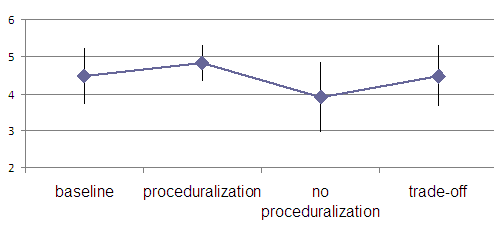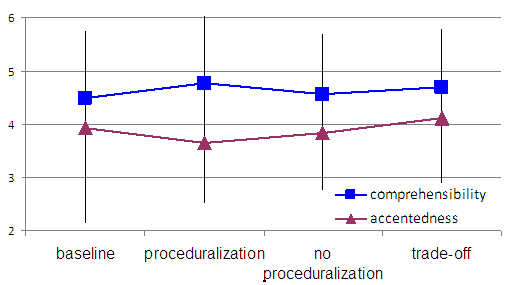Difference between revisions of "Fluency Summer Intern Project 2009"
m (→Further information) |
|||
| (13 intermediate revisions by the same user not shown) | |||
| Line 1: | Line 1: | ||
| − | |||
| − | |||
== Abstract == | == Abstract == | ||
| − | ... | + | The goal of this study is to investigate whether patterns evidencing the use of proceduralized knowledge by English as a Second Language (ESL) speakers are perceived by native-speaker listeners. Four sets of one-minute excerpts were selected based on a combination of three fluency measures: mean length of fluent runs, mean length of pauses, and phonation/time ratio. Excerpts were chosen so that they represented different levels of proceduralization: baseline, proceduralization, no proceduralization, trade-off. Results showed that fluency ratings followed the hypothesized pattern: no proceduralization < baseline = trade-off < proceduralization. However, the one-way ANOVA was not significant. Mean ratings for comprehensibility and accentedness followed slightly different patters. The correlation between fluency ratings and articulation rate suggests raters may have based their judgment on articulation rate instead of proceduralization evidence. This study suggests that native-speaker raters are influenced by patterns of temporal measures that indicate proceduralization or articulation rate. |
== Background and significance == | == Background and significance == | ||
| Line 9: | Line 7: | ||
The goal of this study is to investigate whether patterns evidencing the use of proceduralized knowledge by English as a Second Language (ESL) speakers are perceived by native-speaker listeners. | The goal of this study is to investigate whether patterns evidencing the use of proceduralized knowledge by English as a Second Language (ESL) speakers are perceived by native-speaker listeners. | ||
| − | The four fluency measures used in this study, and the larger project, are: | + | The four [[fluency]] measures used in this study, and [[Fostering_fluency_in_second_language_learning|the larger project]], are: |
* Mean length of pauses (in seconds) | * Mean length of pauses (in seconds) | ||
* Phonation/time ratio: The percentage of time spent speaking as a proportion of the total time taken to produce the speech sample. | * Phonation/time ratio: The percentage of time spent speaking as a proportion of the total time taken to produce the speech sample. | ||
| Line 21: | Line 19: | ||
== Research question == | == Research question == | ||
| − | * Can native-speaker listeners perceive the use of proceduralized knowledge by ESL speakers, as evidenced by patterns in the fluency measures of mean length of fluent runs, mean length of pauses, and phonation/time ratio? | + | * Can native-speaker listeners perceive the use of proceduralized knowledge by ESL speakers, as evidenced by patterns in the [[fluency]] measures of mean length of fluent runs, mean length of pauses, and phonation/time ratio? |
== Method == | == Method == | ||
| − | Four sets of one-minute excerpts from a large pool of existing audio recordings | + | Four sets of one-minute excerpts from a large pool of existing audio recordings were selected. |
:1. Baseline: All fluency measures are average. | :1. Baseline: All fluency measures are average. | ||
:2. Proceduralization: High mean length of fluent runs, other measures average | :2. Proceduralization: High mean length of fluent runs, other measures average | ||
| Line 31: | Line 29: | ||
:4. Trade-off: High mean length of fluent runs, but high mean length of pauses and low phonation/time ratio | :4. Trade-off: High mean length of fluent runs, but high mean length of pauses and low phonation/time ratio | ||
| − | The articulation rate of all excerpts | + | The articulation rate of all excerpts was kept as constant as possible. The first language of all speakers was Chinese. |
== Independent variables == | == Independent variables == | ||
| Line 39: | Line 37: | ||
== Dependent variables == | == Dependent variables == | ||
* a. Native speaker ratings, 7-point scale: | * a. Native speaker ratings, 7-point scale: | ||
| − | **Fluency | + | **[[Fluency]] |
**Comprehensibility | **Comprehensibility | ||
**Accentedness | **Accentedness | ||
| Line 54: | Line 52: | ||
== Findings == | == Findings == | ||
| − | The | + | * The fluency ratings followed the hypothesized pattern, but the one-way ANOVA comparing the four types was not significant. |
| + | * The patterns of ratings for comprehensibility and accentedness were different from the fluency ratings, which indicates that those ratings were mostly independent of each other. | ||
| + | |||
| + | * There was a strong correlation between fluency ratings and articulation rate (''r'' = .603), and between articulation rate and mean length of fluent runs (''r'' = .616), but not between fluency ratings and mean length of fluent runs (''r'' = .197). This indicates that the native-speaker listeners may have based their fluency ratings mostly on articulation rate. | ||
| + | |||
| + | [[Image:SI09_poster_Figure1.gif|Mean Fluency Ratings per Type]] [[Image:SI09_poster_Figure2.gif|Mean Ratings of Comprehensibility and Accentedness per Type]] | ||
| + | |||
| + | * The rater's comments and their familiarity with the speakers' L1 (Chinese) were not analyzed. | ||
== Explanation == | == Explanation == | ||
| Line 68: | Line 73: | ||
The data preparation and analysis of this part of the project has been performed by Maya Randolph from Bard College at Simon's Rock (summer intern in June-July 2009), under supervision of Mary Lou Vercellotti and Dr. Laura Halderman from the University of Pittsburgh, and Dr. Nel de Jong from Queens College of CUNY. | The data preparation and analysis of this part of the project has been performed by Maya Randolph from Bard College at Simon's Rock (summer intern in June-July 2009), under supervision of Mary Lou Vercellotti and Dr. Laura Halderman from the University of Pittsburgh, and Dr. Nel de Jong from Queens College of CUNY. | ||
| + | |||
| + | This internship was part of the project [[Fostering_fluency_in_second_language_learning|Fostering fluency in second language learning]] by Nel de Jong, Laura Halderman, and Charles Perfetti. | ||
Latest revision as of 13:54, 1 August 2009
Contents
Abstract
The goal of this study is to investigate whether patterns evidencing the use of proceduralized knowledge by English as a Second Language (ESL) speakers are perceived by native-speaker listeners. Four sets of one-minute excerpts were selected based on a combination of three fluency measures: mean length of fluent runs, mean length of pauses, and phonation/time ratio. Excerpts were chosen so that they represented different levels of proceduralization: baseline, proceduralization, no proceduralization, trade-off. Results showed that fluency ratings followed the hypothesized pattern: no proceduralization < baseline = trade-off < proceduralization. However, the one-way ANOVA was not significant. Mean ratings for comprehensibility and accentedness followed slightly different patters. The correlation between fluency ratings and articulation rate suggests raters may have based their judgment on articulation rate instead of proceduralization evidence. This study suggests that native-speaker raters are influenced by patterns of temporal measures that indicate proceduralization or articulation rate.
Background and significance
The goal of this study is to investigate whether patterns evidencing the use of proceduralized knowledge by English as a Second Language (ESL) speakers are perceived by native-speaker listeners.
The four fluency measures used in this study, and the larger project, are:
- Mean length of pauses (in seconds)
- Phonation/time ratio: The percentage of time spent speaking as a proportion of the total time taken to produce the speech sample.
- This measure is related to the number of pauses in a speech: if the mean length of pauses is stable but the number of pauses decreases, phonation/time ratio increases.
- Mean length of fluent runs: The mean number of syllables produced between pauses.
- Articulation rate (in syllables per minute): The total number of syllables produced divided by the amount of time taken to produce them, excluding pause time.
- This measure is slightly different from speech rate, which includes pause time.
As explained below, the combination of these measures can give an indication of the proceduralization of knowledge.
Research question
- Can native-speaker listeners perceive the use of proceduralized knowledge by ESL speakers, as evidenced by patterns in the fluency measures of mean length of fluent runs, mean length of pauses, and phonation/time ratio?
Method
Four sets of one-minute excerpts from a large pool of existing audio recordings were selected.
- 1. Baseline: All fluency measures are average.
- 2. Proceduralization: High mean length of fluent runs, other measures average
- 3. No proceduralization: Low mean length of fluent runs, other measures average
- 4. Trade-off: High mean length of fluent runs, but high mean length of pauses and low phonation/time ratio
The articulation rate of all excerpts was kept as constant as possible. The first language of all speakers was Chinese.
Independent variables
- Level of proceduralization (baseline, proceduralization, no proceduralization, trade-off)
Dependent variables
- a. Native speaker ratings, 7-point scale:
- Fluency
- Comprehensibility
- Accentedness
- b. Native speaker comments about factors influencing ratings
- c. Native speakers' familiarity with the first language of the ESL speakers (Chinese)
Hypotheses
- Compared to the baseline, fluency ratings are higher for the "proceduralization" excerpts
- Compared to the baseline, fluency ratings are lower for the "no proceduralization" excerpts
- Compared to the baseline, fluency ratings are similar for the "trade-off" excerpts
The ratings of comprehensibility and accentedness may vary across speakers, but should be independent of fluency ratings.
Findings
- The fluency ratings followed the hypothesized pattern, but the one-way ANOVA comparing the four types was not significant.
- The patterns of ratings for comprehensibility and accentedness were different from the fluency ratings, which indicates that those ratings were mostly independent of each other.
- There was a strong correlation between fluency ratings and articulation rate (r = .603), and between articulation rate and mean length of fluent runs (r = .616), but not between fluency ratings and mean length of fluent runs (r = .197). This indicates that the native-speaker listeners may have based their fluency ratings mostly on articulation rate.
- The rater's comments and their familiarity with the speakers' L1 (Chinese) were not analyzed.
Explanation
Perceived fluency can be considered the perception by the listener of the ease of production by the speaker.
Ease of production is related to the use of proceduralized knowledge, which requires less attentional resources than declarative knowledge. Towell, Hawkins, and Bazergui (1996) argue that three fluency measures in combination can be used as indicators of proceduralization: mean length of fluent runs, mean length of pauses, and phonation/time ratio. If the mean length of fluent runs increases while the mean pause length and phonation/time ratio are stable, more silent planning time was not needed, which indicates that encoding and sentence building have been proceduralized.
Note: Articulation rate is a measure of the speed of articulatory processes, and is thus not strongly related to proceduralization of lexical and syntactic knowledge.
Further information
The data preparation and analysis of this part of the project has been performed by Maya Randolph from Bard College at Simon's Rock (summer intern in June-July 2009), under supervision of Mary Lou Vercellotti and Dr. Laura Halderman from the University of Pittsburgh, and Dr. Nel de Jong from Queens College of CUNY.
This internship was part of the project Fostering fluency in second language learning by Nel de Jong, Laura Halderman, and Charles Perfetti.

